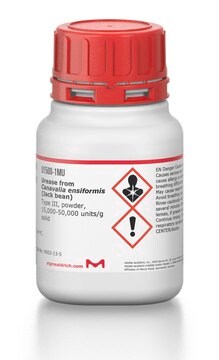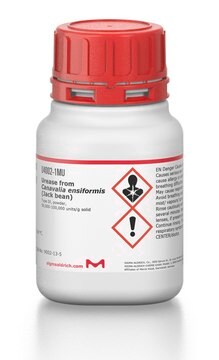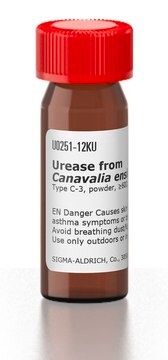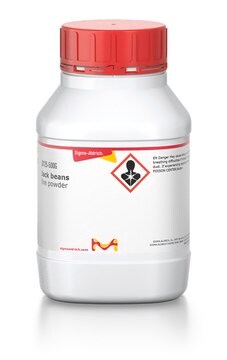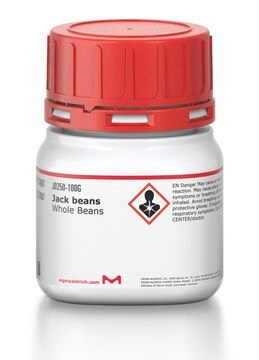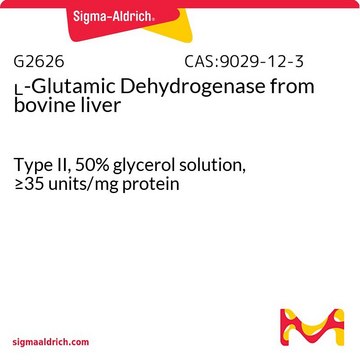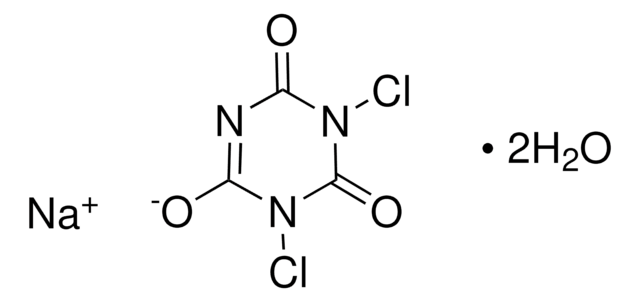U1875
Urease from Canavalia ensiformis (Jack bean)
Type III, glycerol solution, 500-800 units/mL
Synonym(s):
Jack bean urease, Urea amidohydrolase
Sign Into View Organizational & Contract Pricing
All Photos(1)
About This Item
CAS Number:
MDL number:
UNSPSC Code:
12352204
eCl@ss:
32160410
NACRES:
NA.54
Recommended Products
biological source
Canavalia ensiformis
Quality Level
type
Type III
form
glycerol solution
mol wt
~544620
concentration
500-800 units/mL
storage temp.
2-8°C
Looking for similar products? Visit Product Comparison Guide
General description
Subunit molecular weight: ~90,770
Composed of six subunits with total molecular weight: ~544,620
Composed of six subunits with total molecular weight: ~544,620
Urease of jack bean (Canavalia ensiformis), a hexamer of a single chain of 840 amino acid residues, is found in plants, bacteria, fungi, algae, and soil. It is considered the first nickel-containing enzyme and the first enzyme to be crystallized. Ureases exist in several isoforms, some are jack bean urease (JBURE-I), canatoxin (CNTX), and JBURE-IIB. JBURE-I is more abundant than the other two isoforms. Ureases are found in mature seeds.
Application
Urease from Canavalia ensiformis (Jack bean) has been used:
- to assay creatine and creatine phosphate using the sample extracted from the left ventricle (LV) and septal tissue
- to determine the concentration of urea in a stabilized urine sample
- as one of the standards to measure the urease activity of plant extracts
Biochem/physiol Actions
In plants, ureases are essential for the bioavailability/metabolism of nitrogen in nature and defense mechanisms. Ureases are metalloenzymes that catalyze the hydrolysis of urea to release ammonia a nitrogen source for growth and carbon dioxide. They exhibit internal peptides-mediated insecticidal action and fungicidal activity.
Urease activity has been shown to be inhibited by benzpyrene following exposure to light. This inhibition was due to the effect of benzpyrene on urease′s sulfhydryl groups.
Unit Definition
One micromolar unit will liberate 1.0 μmole of NH3 from urea per min at pH 7.0 at 25 °C. It is equivalent to 1.0 I.U. or 0.054 Sumner unit (1.0 mg ammonia nitrogen in 5 minutes at pH 7.0 at 20 °C)
Signal Word
Danger
Hazard Statements
Precautionary Statements
Hazard Classifications
Eye Irrit. 2 - Resp. Sens. 1 - Skin Irrit. 2 - STOT SE 3
Target Organs
Respiratory system
Storage Class Code
10 - Combustible liquids
WGK
WGK 1
Flash Point(F)
Not applicable
Flash Point(C)
Not applicable
Choose from one of the most recent versions:
Already Own This Product?
Find documentation for the products that you have recently purchased in the Document Library.
Customers Also Viewed
Effect of light-activated benzpyrene on urease activity.
G C MILLS et al.
Cancer research, 13(1), 69-72 (1953-01-01)
Nizam Uddin et al.
Fitoterapia, 84, 202-207 (2012-10-30)
Seven constituents were isolated from the stems of Lawsonia alba Lam., following an activity-guided isolation, which include two new constituents, namely lawsorosemarinol (1) and lawsofructose (2), one known compound 2-(β-d-glucopyranosyloxy)-1, 4-naphthoquinone (3) and four compounds, 4-hydroxy coumarine (4), 3-(4-hyroxyphenyl)-triacontyl-(Z)-propenoate (5)
Brian H Eisner et al.
The Urologic clinics of North America, 40(1), 21-30 (2012-11-28)
This article reviews the data on pharmacologic treatment of kidney stone disease, with a focus on prophylaxis against stone recurrence. One of the most effective and important therapies for stone prevention, an increase in urine volume, is not discussed because
Yi Wen et al.
Journal of bacteriology, 195(3), 444-452 (2012-10-30)
Urease is an essential component of gastric acid acclimation by Helicobacter pylori. The increased level of urease in gastric acidity is due, in part, to acid activation of the two-component system consisting of the membrane sensor HP0165 (ArsS) and its
Lisa G Kuhns et al.
The Biochemical journal, 450(1), 141-148 (2012-11-28)
The persistence of the gastric pathogen Helicobacter pylori is due in part to urease and Msr (methionine sulfoxide reductase). Upon exposure to relatively mild (21% partial pressure of O2) oxidative stress, a Δmsr mutant showed both decreased urease specific activity
Articles
probiotics-and-human
Our team of scientists has experience in all areas of research including Life Science, Material Science, Chemical Synthesis, Chromatography, Analytical and many others.
Contact Technical Service